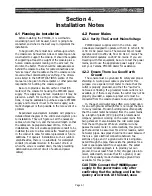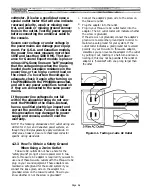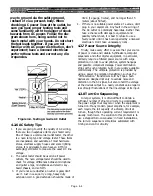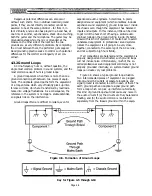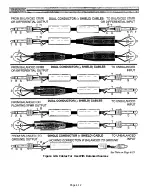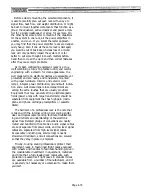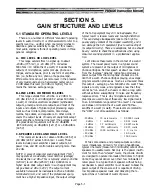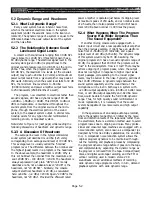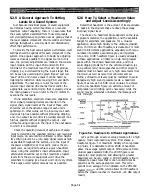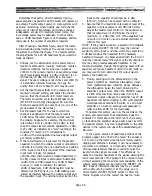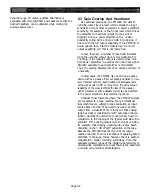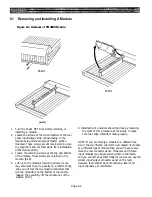
designed to recognize only the difference in voltage
between the two wires, and (hence the term “balanced
differential input”). Should any electrostatic interfer-
ence or noise cut across a balanced cable, the noise
voltage will appear equally - with the same polarity -
on both signal-carrying wires. The noise is therefore
ignored or “rejected” by the input circuit. (This is why
the term “common mode rejection” applies; signals in
common to the two center wires are rejected.)
Not all balanced wiring has a shield. In older tele-
phone systems, many miles of cable were run with no
shielding in order to save money (now fiber optic cables
are replacing costly copper with inexpensive glass or
plastics). Out in the open, wires are subjected to radio
interference and to hum fields emitted by power lines.
Balancing the two signal hot wires with respect to
ground gives long lines immunity to external interfer-
ence. Twisting two wires together theoretically subjects
each wire to the same amount of electrostatic or electro-
magnetic noise. A balanced input will then cancel the
unwanted noise signals common to both wires, while
passing the desired audio signal, as illustrated in
Figures 4-14.
The RFI (radio frequency interference) cuts across both
conductors, inducing equal voltages in the same direc-
tion. These voltages “meet” in the differential amplifier
(or transformer), and cancel out, while the signals
generated by the microphone flow in opposite directions
in each conductor, and hence do not cancel out. Thus, in
a theoretically perfect balanced system, only the desired
signal gets through the differential amplifier or trans-
former.
Figure 4-14. Noise Rejection In a Balanced Line
NOTE regarding Figure 4-14. There are significant
differences in the way various balanced outputs are
designed. When a balanced output is driving an unbal-
anced input, it is best to use a dual-conductor shielded
cable, connecting the shield at both ends and allowing
the low side of the cable to join the shld at the unbal-
anced input end of the cable. This provides most of the
hum protection of a fully balanced line. In some cases,
notably with a balanced to ground otuput, it is best to
use a single conductor shielded cable, as illustrated in
Figure 4-13. In other cases, such as in equipment racks
were jacks are grounded through the rack frame, it may
prove necessary to cut the shield at the output end of the
cable. Unfortunately, there is no one right way to make a
cable for all installations.
4.4.4 The Pro’s And Con’s of
Input Transformers
As illustrated, there are two means to achieving a
balanced input; either with a transformer or with a
differentially balanced amplifier (an “electronically
balanced input”). The latter approach is used in the
PM4000, and was chosen for several reasons: (1) it is
more “transparent” sounding than most transformer
inputs, (2) it cannot be saturated by low frequency,
high-level signals as can a transformer, (3) it is lighter
in weight.
There are a number of reasons why input transform-
ers are used in some installations. In the case of certain
audio equipment which has an unbalanced input (not
this console), a transformer converts the unbalanced
input to a balanced input. Beyond that, there are cases
Page 4-13
Summary of Contents for PM4000
Page 1: ...PROFESSIONAL AUDIO MIXING CONSOLE PM4000 OPERATING MANUAL YAMAHA ...
Page 2: ...PM4000 OPERATING MANUAL ...
Page 7: ...Section 1 Introduction ...
Page 11: ...Section 2 Brief Operating Instruction ...
Page 47: ...Section 3 Specifications ...
Page 51: ...Dimensional Drawings PM4000 Console all versions Page 3 4 ...
Page 52: ...Page 3 5 ...
Page 53: ...Page 3 6 PM4000 Console Rear Profiles ...
Page 54: ...Module Block Diagrams See back of the manual for overall system block diagram Page 3 7 ...
Page 55: ...Page 3 8 ...
Page 56: ...Page 3 9 ...
Page 57: ...Page 3 10 ...
Page 58: ...Page 3 11 ...
Page 59: ...Page 3 12 ...
Page 60: ...Section 4 Installation Notes ...
Page 72: ...Figure 4 13 Cables For Use With Balanced Sources Page 4 12 ...
Page 79: ...SECTION 5 Gain Structure and Levels ...
Page 82: ...Figure 5 1 Dynamic Range and Headroom in Sound Systems Page 5 3 ...
Page 86: ...Section 6 Optional Functions ...
Page 106: ...Section 7 Operating Notes and Hints ...
Page 119: ...Section 8 Applications ...
Page 127: ...Section 9 Maintenance ...
Page 131: ......
Page 132: ...YAMAHA VN02300 ...



